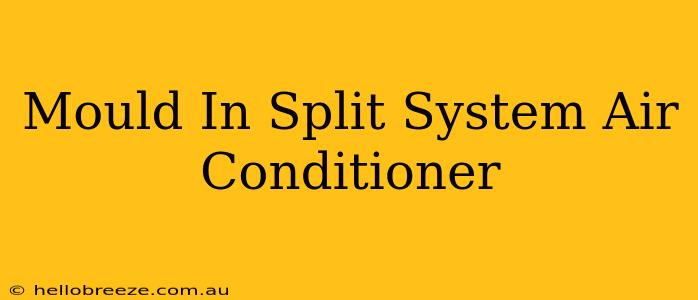Mould growth in your split system air conditioner is a common problem, impacting both the efficiency of your unit and the air quality in your home. This comprehensive guide will explore the causes, consequences, and solutions for dealing with mould in your split system air conditioner. We’ll cover everything from preventative measures to effective cleaning techniques, ensuring a healthier and more efficient cooling system.
Understanding the Mould Problem
Mould thrives in damp, dark environments – conditions readily available within the confines of your air conditioning unit. Warm, humid air circulating through the system provides the perfect breeding ground for various mould species. This mould can then be dispersed throughout your home, potentially triggering allergies and respiratory problems.
Common Causes of Mould Growth
Several factors contribute to mould growth in split system air conditioners:
- Condensation: The process of cooling air produces condensation, creating moisture that accumulates within the unit.
- Poor Airflow: Restricted airflow prevents the evaporation of moisture, leading to increased humidity.
- Lack of Maintenance: Regular cleaning and maintenance are crucial to prevent mould accumulation.
- Leaks: Water leaks within the system create ideal conditions for mould growth.
- Dirty Filters: Clogged air filters restrict airflow and increase humidity.
The Dangers of Ignoring Mould
Ignoring mould growth in your air conditioner isn't just an inconvenience; it poses significant health risks:
- Respiratory Issues: Mould spores can trigger allergic reactions, asthma attacks, and other respiratory problems.
- Infections: In some cases, mould can lead to serious infections, particularly for individuals with weakened immune systems.
- Reduced Air Quality: Mould contamination significantly reduces the quality of the air circulating throughout your home.
- System Damage: Mould can corrode internal components of your air conditioner, shortening its lifespan and potentially leading to costly repairs.
Preventing Mould Growth: Proactive Steps
Preventing mould is far easier and cheaper than dealing with a full-blown infestation. Here are some proactive measures:
- Regular Filter Cleaning: Change or clean your air filters every 4-6 weeks, or more frequently if you live in a dusty environment. A clean filter ensures optimal airflow.
- Annual Professional Maintenance: Schedule an annual inspection and cleaning by a qualified HVAC technician. They can identify and address potential problems before they escalate.
- Proper Ventilation: Ensure adequate ventilation in the rooms where your air conditioner operates. This helps prevent excessive humidity build-up.
- Address Leaks Promptly: Repair any water leaks immediately to prevent moisture accumulation.
- Inspect Regularly: Regularly inspect your air conditioner's coils and other components for signs of mould growth.
Cleaning Your Split System Air Conditioner: A Step-by-Step Guide
While professional cleaning is recommended annually, you can perform some basic cleaning tasks yourself:
Note: Always disconnect the power supply before cleaning your air conditioner.
- Remove the Filter: Carefully remove the air filter and clean it according to the manufacturer's instructions.
- Clean the Coils: Use a coil cleaning solution and a soft brush to gently clean the evaporator and condenser coils.
- Dry Thoroughly: Allow all components to dry completely before reassembling.
- Inspect for Damage: Check for any signs of damage or leaks during cleaning.
When to Call a Professional
If you notice significant mould growth, persistent musty odors, or suspect a leak, it’s crucial to contact a qualified HVAC technician. They possess the expertise and equipment to thoroughly clean and disinfect your air conditioner, ensuring a safe and healthy environment.
Conclusion
Maintaining a clean and mould-free split system air conditioner is essential for both your health and the longevity of your unit. By following the preventative measures and cleaning guidelines outlined above, you can significantly reduce the risk of mould growth and enjoy cleaner, healthier air in your home. Remember, prevention is key, but professional assistance is invaluable when dealing with significant mould issues.

